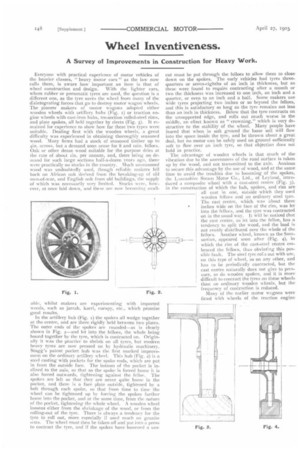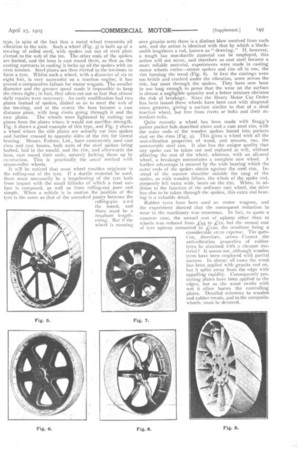Wheel Inventiveness.
Page 12

Page 13

If you've noticed an error in this article please click here to report it so we can fix it.
A Survey of Improvements in Construction for Heavy Work.
Everyone with practical experience of motor vehicles of the heavier classes, " heavy motor cars " as the law now calls them, is aware how important an item is that of
wheel construction and design. With the lighter cars, where rubber or pneumatic tyres are used, the question is a different one, as the tyre saves the wheel from many of the disintegrating forces that go to destroy motor wagon wheels. The pioneer makers of motor \vagons adopted either wooden wheels with artillery hubs (Fig. .1) or traction engine wheels with cast-iron hubs, tee-section rolled-steel rims, and plate spokes, all held together by rivets (Fig. 5). It remained for experience to show how far these two types were suitable. Dealing first with the wooden wheels, a great difficulty was experienced in obtaining thoroughly seasoned wood. Many firms had a stock of seasoned timber up to 4in. across, but a demand soon arose for 8 and min. felloes. Oak or other dense wood suitable for the purpose dries at the rate of about tin. per annum, and, there being no demand for such large sections half-a-dozen years ago, there were practically no stocks in the country. Much unseasoned wood was undoubtedly used, though reliable makers fell back on African oak derived from the breaking-up of old men-of-war, and English oak from old buildings, the supply of which was necessarily very limited. Stocks %Vert', however, at once laid down, and these are now becoming avail
able, whilst makers are experimenting with imported woods, such as jarrah, karri, curopy, etc., which promise good results.
In the artillery hub (Fig. i) the spokes all wedge together at the centre, and are there rigidly held between two plates. The outer ends of the spokes are rounded—as is clearly shown in Fig_ 2 —a nd let into the felloes, the whole being bound together by the tyre, which is contracted on. Originally it was the practice to shrink on all tyres, but modern heavy tyres are now pressed on by hydraulic machinery. Stagg's patent pocket hub was the first marked improvement on the ordinary artillery wheel. This hub (Fig. 2) is a steel casting with pockets for the spoke ends, which are put in from the outside face. The bottom of the pocket is inclined to the axis, so that as the spoke is forced home it is also forced outwards, tightening against the fella,. The spokes are left so that they are never quite home in the pocket, and there is a face plate outside, tightened by a bolt through each spoke, so that from time to time the wheel can be tightened up by forcing the spokes further home into the pocket, and at the same time, from the nature of the pocket, tightening the whole wheel. A wooden wheel loosens either from the shrinkage of the wood, or from the rolling-out of the tyre. There is always a tendency for the tyre to roll out, more especially if used much on granite setts. The wheel must then be taken off and put into a press to contract the tyre, and if the spokes have loosened a saw
cut must be put through the felloes to allow them to close. down on the spokes. The early vehicles had tyres threequarters or seven-eighths of an inch in thickness, but as these were found to require contracting after a month or two the thickness was increased to one inch, an inch and a quarter, or even to an inch and a half. Some makers use wide tyres projecting two inches or so beyond the felloes, and this is satisfactory so long as the tyre remains not less. than an inch in thickness. Below that the tyre contracts on the unsupported edge, and rolls out much worse in the middle, an effect known as " crowning," which is very destructive to the stability of the wheel. Many people have feared that when in soft ground the loose soil will flow into the space inside the tyre, and be thrown about a great deal, but no motor can be safely used on ground sufficiently soft to flow over an inch tyrc, so that objection does not hold in practice. The advantage of wooden wheels is that much of the vibration due to the unevenness of the road surface is taken up by the wood, and not transmitted to the axle. Anxious. tosecure this advantage by the use of wood, and at the sometime to avoid the troubles due to loosening of the spokes, the Lancashire Steam Motor Co., Ltd., of Leyland, introduced a composite wheel with a cast-steel centre (Fig. 3), in the construction of which the hub, spokes, and rim are al] cast in one, outside which they used
wooden felloes and, an ordinary steel tyre. The cast centre, which was about three inches wide on the face of the rim, was let into the felloes, and the tyre was contracted on in the usual way. It will be noticed that the cast centre, as let into the felloe, has a tendency to split the wood, and the load is not evenly distributed over the whole of the fella's. Another wheel, known as the Sam.. sonian, appeared soon after (Fig. 4), in which the rim of the cast-steel centre embraced the felloes, thus obviating this possible fault. The steel tyre rol:z., out with use, on this type of wheel, as on any other, and has to be periodically contracted, but the cast centre naturally does not give to pressure, as do wooden spokes, and it is more difficult to contract the tyres on these wheels than on ordinary wooden wheels, but the frequency of contraction is reduced.
Many of the earlier motor wagons were fitted with wheels of the traction engine
type, in spite of the fact that a metal wheel transmits all vibration to the axle. Such a wheel (Fig. 5) is built up of a tee-ring of rolled steel, with spokes cut out of steel plate riveted to the web of the tee. The other ends of the spokes are barbed, and the boss is cast round them, so that as the casting contracts in cooling it locks up all the spokes with an even tension. Steel plates are then riveted to the tee-irons to form a tyre. Whilst such a wheel, with a diameter of six to eight feet, is very successful on a traction engine, it has proved a comparative failure for motor wagons. The smaller diameter and the greater speed made it impossible to keep the rivets tight ; in fact, they often cut out so fast that almost daily repairs were necessary. An early modification had two plates instead of spokes, dished so as to meet the web of the tee-ring, and at the centre the boss became a cast distance piece, with long rivets going through it and the
two plates. The wheels were lightened by cutting out pieces from the plates where it would not sacrifice strength. Fig. 6 shows a good example of this type, and Fig. 7 shows a wheel where the side plates are actually cut into spokes and further crossed to opposite sides of the rim for lateral bracing. Messrs. Fodens, Ltd., have consistently used cast rims and cast bosies, both ends of the steel spokes being barbed, laid in the mould, and the rim, and afterwards the boss, cast round their ends, securely lockingthem up by coatraction. This is practically the usual method with steam-roller wheels.
It will be noticed that most wheel troubles originate in the rolling-out of the tyre. If a ductile material be used, there must necessarily be a lengthening of the tyre both from impact with the small hillocks of which a road surface is composed, as well as from rolling-out pure and simple. When a vehicle is in motion the position of the tyre is the same as that of the uncooked pastry between the rolling-pin a n d the board, and there must be a resultant lengthening. But if the wheel is running over granite setts there is a distinct blow received from each' sett, and the action is identical with that by which a black-smith lengthens a rod, known as " drawing." If, however, a tough but non-ductile material can be employed, this action will not occur, and therefore as cast steel became a more reliable material, experiments were made in casting motor wheels entire--centre spokes and rim all in one, therim forming the tread (Fig. 8). At first the castings were too brittle and cracked under the vibration, some across the' rim, but most through the spokes. They have now been in use long enough to prove that the wear on the surface is almost a negligible quantity and a better mixture obviates the risk of breakage. Since the Heavy Motor Car Order has been issued these wheels have been cast with diagonal. cross grooves, giving a surface similar to that of a shod traction wheel, but free from rivets or bolts and their attendant evils.
Quite recently a wheel has been made with Stagg's. patent pocket hub described above and a cast steel rim, with the outer ends of the wooden spokes forced into pockets cast on the rims (Fig. 9). This gives a wheel with all the anti-vibration properties of wood, and secures, too, the unwearable steel rim. It also has the unique quality that any spoke can be taken out and replaced at will, without affecting the rest of the wheel, whereas, with an all-steel wheel, a breakage necessitates a complete new wheel. A further advantage is secured by the wide bearing which the outer ends of the spokes obtain against the steel rim. Instead of the narrow shoulder outside the tang of the spoke, as with wooden felloes, the whole of the spoke end, purposely left extra wide, bears on the rim. When, in addition to the function of the ordinary cart wheel, the drive has also to be taken through the spokes, this extra end bearing is a valuable detail.
Rubber tyres have been used on motor wagons, and the experiment showed that the consequent reduction in wear to the machinery was enormous. In fact, to quote a concrete case, the annual cost of upkeep other than to wheels was reduced from L.:95 to .4:22, but the annual cost of tyre upkeep amounted to £120, the resultant being a
considerable ex:ra expense. The ques t'on, therefore, arises—.Cannot the anti-vibration properties of rubber tyres be obtained with a cheaper material? It seems not, although wooden tyres have been employed with partial success. In almost all cases the wood has been applied with granite end on, but it splits away from the edge with appalling rapidity. Consequently protecting plates have been applied to the edges, but as the wood swells with wet it often bursts the controlling plates. Detailed reference to wooden and rubber treads, and to the composite wheels, must be deferred.




















